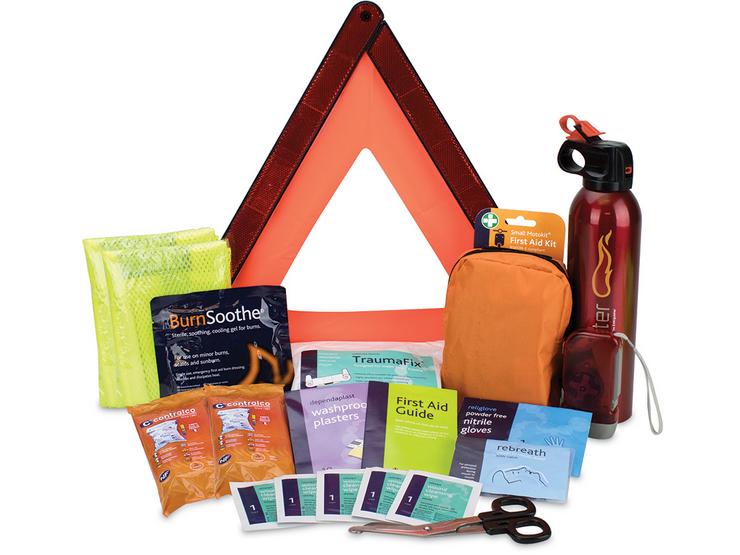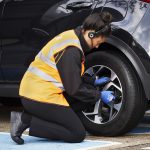A car breakdown can be a stressful situation, especially if it’s something you’ve not experienced before. If you notice something wrong with your vehicle mid-journey, try to remain calm and find the safest place to stop.
If you’re not sure what to do next, we’ve extracted the key points from the Highway Code to help you take control in the event of a car breakdown.
Key points to remember when your car breaks down
While experiencing a breakdown can be overwhelming, here are the key points to remember:
Stopping safely
If you start to notice an issue with your vehicle, it’s important to remain calm and be wary of other road users.
If you’re on the motorway, The Highway Code says to leave at the next exit or pull into a service area. If this isn’t possible, you should pull onto the hard shoulder and stop as far to the left as possible, whilst taking care of any soft verges, and stop with your wheels turned to the left.
If you can’t get onto the hard shoulder, try to get into the leftmost lane. It’s safest to stay in your car with your seatbelt and hazard warning lights on.
If you’re on a smart motorway without a hard shoulder, then try to exit the motorway at the nearest junction, service station, or emergency refuge area. These sections are highlighted by orange SOS signs.
If you break down on a country road, ensure your vehicle is pulled over as far as possible to the left to avoid blocking other road users.
Once you’ve stopped, you should turn on your hazard warning lights to alert other road users. If it’s dark, you should also turn on your sidelights.
Getting out of the car
Leave the car by using the passenger side door, so that you’re not at risk of oncoming traffic. Make sure everyone in the car does the same, whether using the front or rear passenger door. Ensure that everyone stands well away from the road.
If you break down on a motorway, move up the verge if it’s possible. If you have a hi-vis jacket handy, then you should put this on so that it’s easier for others to see you.
Warning triangles should never be used on a motorway as there’s a risk in even trying to put it out. If you’re on a normal road, and it’s safe, you can put a warning triangle at least 45m behind your car.
If you need items such as a hi-vis jacket or a warning triangle, we recommend the Reliance Medical Accident Emergency and Breakdown Kit, as it has everything you need to prepare you for breakdown situations.
Leave pets in the car
It’s not considered safe to get your pets out of the car, even though you might want to. The Highway Code advises that pets should be left in the car, unless of emergency e.g. if the car is smoking or badly damaged. If that’s the case, take them out of the car but make sure they are kept under control, whether on a leash or in a pet carrier.
Call your breakdown service
When everyone is safely out of the vehicle, and away from moving traffic, you should call your breakdown service. Even simple repairs shouldn’t be attempted.
If you don’t have a phone with you, and you’re on the motorway, walk to an emergency phone which will connect you directly to the Highways Agency or the police. These are located at one-mile intervals along the hard shoulder and can be easily identified as bright orange boxes.
When using the phone, don’t turn your back on the traffic as you need to be as visible as possible to road users.
On the call, provide as much information as you can, including location and who you’re travelling with. If you’re travelling alone, are disabled or in the company of children, mention this as it’ll indicate that you’re in a vulnerable situation.
Getting back to your car
Once you’ve returned to your car, wait at a safe distance away from your vehicle until help arrives. If you have reason to feel at risk from another person during this time, get into your car from one of the passenger doors and lock the car.
What if I don’t have breakdown cover?
If you’ve broken down and don’t have breakdown cover, you’re still able to call a breakdown service provider who can offer you instant emergency cover. You will be charged a fee for emergency cover; however, it means they will be able to send help as soon as possible.
Don’t attempt to buy standard breakdown cover if you’re already broken down as most plans take 24 hours to come into force.
Whether you have breakdown cover or not, if you’ve broken down on a motorway, you should call emergency services as this is a more dangerous situation. Equally, if you’ve broken down and anyone in the car is hurt, call 999 as soon as possible.
We hope this blog has provided clear guidance on what to do if your car breaks down. If you don’t have breakdown cover, we advise that you take cover out as soon as you can.
For extra peace of mind while on the road, Halfords offer a range of services to ensure your car is in top condition. From our 10 point car check to a full service, our experts will inspect your vehicle and ensure it’s road ready. Explore our range of motoring services on halfords.com.


